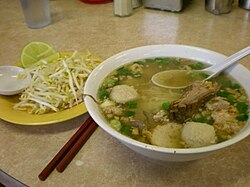Cambodian Chinese cuisine

| Part of a series on |
| Chinese cuisine |
|---|
 |
| Regional cuisines
|
| Overseas cuisine |
| Ingredients and types of food |
|
|
Cambodian Chinese cuisine is a food tradition distinct from both Khmer and Chinese cuisines developed by the Cambodian Chinese living in Cambodia.[1] The foodways of the Chinese Cambodians have not only been influenced by the Khmer but also by the Vietnamese and Chinese Vietnamese foodways.[2]
The Chinese began migrating to Khmer Empire in the 13th century, bringing their cuisine with them, from which the Khmer cuisine adopted noodles, soy sauce, different vegetables, stir frying, steaming and the custom of eating soup for breakfast.[3] Until the mid-20th century, the Chinese that mostly migrated to Cambodia were Teochews and to a lesser extent also Hainans, Hakkas, and Cantonese.[4] Nowadays, the Teochew kway teow has become a popular dish in Cambodia, where it is eaten for breakfast, lunch and dinner or as a snack and often flavoured with lime, chili, fish sauce, and palm sugar.[5] Other Cambodian Chinese dishes include lort cha,[6] babor,[7] bai cha,[8] chai yor,[9] and num kroch.[10]
References
- ^ Van Esterik, Penny (2008). Food Culture of Southeast Asia. Greenwood Press. p. 86. ISBN 978-0-313-34419-0.
- ^ Chee-Beng Tan, ed. (2011). Chinese Food and Foodways in Southeast Asia and Beyond. NUS Press. p. 18. ISBN 978-9-971-69548-4.
During my trip to Phnom Penh in August 2009 to look into the Chinese food scene, I found that many localized Chinese Cambodians were from families or individuals who had re-emigrated from Vietnam, and the migration from Vietnam continues to this day. (...) Thus the foodways of the localized Chinese in Cambodia are influenced not only by the Khmer foodways but also by the Vietnamese and Chinese Vietnamese foodways.
- ^ De Monteiro, Longteine; Neustadt, Katherine (1998). The Elephant Walk Cookbook: Cambodian Cuisine from the Nationally Acclaimed Restaurant. Houghton Mifflin Harcourt. pp. 27–28. ISBN 0395892538.
The Chinese introduced us to soy sauce and noodles, a host of new vegetables, the arts of stir-frying and steaming and the custom of having soup for the morning meal
- ^ Chee-Beng Tan, ed. (2011). Chinese Food and Foodways in Southeast Asia and Beyond. NUS Press. p. 177. ISBN 978-9-971-69548-4.
The distribution of Chinese cuisines in Southeast Asia is underscored by the routes of Chinese (im)migration, which were organized along regional, lineage, or dialect lines until the mid-twentieth century. For instance, Teochews tended to migrate to Thailand, Laos, and Cambodia; Hokkiens tended to migrate to Malaysia, Singapore, Indonesia and the Philippines. Hainanese, Hakka, and Cantonese scattered throughout Southeast Asia.
- ^ Chee-Beng Tan, ed. (2011). Chinese Food and Foodways in Southeast Asia and Beyond. NUS Press. pp. 177–178. ISBN 978-9-971-69548-4.
The Teochew term kway teow (rice-flour noodles) has become part of the everyday language of Malaysians, Singaporeans, Cambodians, Laotians and Thais. (...) Kway teow has become a favourite dish, which people in Thailand, Laos, and Cambodia eat for breakfast, lunch and dinner or as a snack. (...) In Thailand, Laos, and Cambodia kway teow often is flavoured with lime, chili, fermented fish sauce, and palm sugar.
- ^ Dunston, Lara (7 December 2020). "Cambodian Lort Cha Recipe for Stir Fried Rice Pin Noodles". Grantourismo Travels. Retrieved 30 March 2024.
- ^ Carter, Terence (18 June 2020). "Cambodian Lort Cha Recipe for Stir Fried Rice Pin Noodles". Grantourismo Travels. Retrieved 30 March 2024.
- ^ Carter, Terence. "Cambodian Fried Rice Recipe – How to Make the Best Bai Cha". Grantourismo Travels. Retrieved 30 March 2024.
- ^ Dunston, Lara (5 January 2021). "Cambodian Fried Spring Rolls Recipe for Crispy Deep-Fried Egg Rolls". Grantourismo Travels. Retrieved 30 March 2024.
- ^ Gérard, Sabrina (20 July 2018). "Num Kroch". 196 flavors. Retrieved 30 March 2024.
 | This article about Cambodian cuisine is a stub. You can help Wikipedia by expanding it. |
- v
- t
- e























